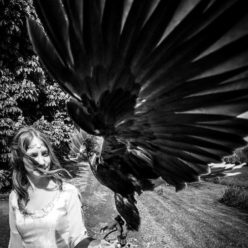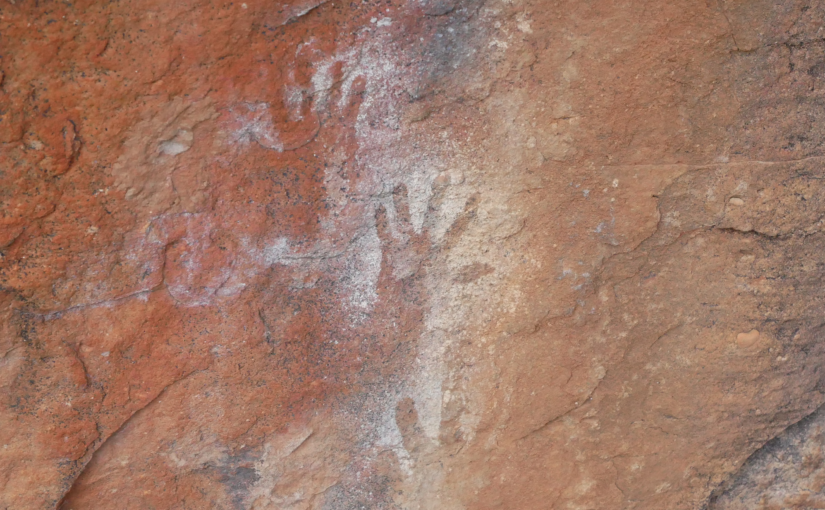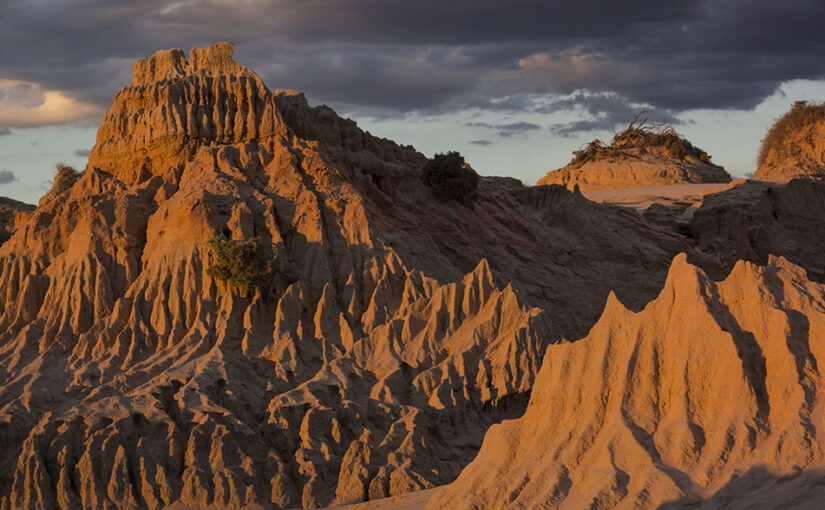I have recently read the most fascinating book called Songlines: The Promise and the Power. It’s by Margo Neale and Lynn Kelly and was published by the National Museum of Australia as part of a series of books about first nation knowledge. The main point of its discussions about archives and Western vs Indigenous knowledge is the stuff that many teachers; mainly primary, have also said for years. To whit: you can remember all kinds of shit if you tie it to a landscape, or if you make up a story about it, or you associate it with a character or you draw a symbol or picture or do a dance or song. This is how Australia’s Indigenous people have recorded knowledge about everything in their country and everything that has happened for 65,000 years. It’s just mind boggling. It made me feel like I wanted to jump straight back in the classroom to try it out.
Don’t worry, it passed.
But linking these things is so powerful. And before reading that book, the effect of it became clear when we drove to Uluru with Nick Cave. The music was all wrong. We had hooked the words of those songs and the emotional feelings about them onto the rust reds of Gunderbooka, the sparkling Brewarrina fish traps, the flower laden spaces of Mungo and the dreamy greys of Grenfell as we chased Spring east and met it for a glass of wine in an Orange vineyard. So, although we shouted Do you love me?? on the long red drive from Alice Springs to Uluru, we felt misplaced, shifted over left. Huh. Something felt missing and the memory of the Red Centre is somehow less….red, than red right handed Gunderbooka. That’s the importance of getting the right music for your road trip; to help you with memory.
Anyway, we flew up to Alice Springs. Hired a car, drove into town between two large mountain ridges which had a lovely dreaming story about caterpillar ancestors crossing the river, and on to exploring.
Even in November (think early May, northern hemisphere), Alice was Hot as Shit. Over 40 degrees but I’ve got all the new-place-excitement going on, so I marched us around until we were both miserable. We visited the Botanic Gardens. They were red earthed with little paths around low eucalypts, desert oaks and wattle with other trees and bushes that probably flower spectacularly… some other time and tried to retain some of the things we learned. There are honey grevilleas and desert roses. Couldn’t point one out if I fell over one. The whole set of gardens was set up by a woman at the start of the 20thC. Couldn’t tell you her name or where she was from. It was very hot, you see, and the black and white photograph of this woman stood in front of the tent she was living in on what would one day become the botanic gardens, wearing far too many layers was beginning to distress me, so we headed back to the hotel to find something to eat.
And here’s my take home about Alice – I had to confront my own unconscious bias as it hopped merrily out of my unconscious and sauntered casually in a flat cap and tweed jacket into my full consciousness. I have never seen so many obviously Aboriginal people. And I didn’t know what to do. They were sitting around, like, on a patch of grass under a tree, on a patch of grass in the town centre (pointedly not on a bench) sometimes on street corners like they were waiting for something (those chaps were – a bus came). While this is all relaxed and what-the-hell-is-your-problem-then, despite all my woke reading about First Nation Knowledge and Pascoe and Maddock, my English brain was just seeing people sat on the floor and wondering if they needed anything, like money or food; are they down on their luck. So for god’s sake don’t be dark skinned and plonk down on the ground, or I’ll clearly think you must be homeless. -_- So I had to confront that in me. I need to do a little work on myself. The next day it continued – we found a positively Canberran café for breakfast; hessian mat rugs, bright cushions, old wooden crates for tables, Bowie on the radio, flat whites and noble food with unknown ingredients served with eggs. And everyone in it was white, and everyone walking past it wasn’t. There seemed to be an unspoken exclusion. Maybe it’s the other way around, maybe Aboriginal people don’t dig flat whites or hipster cafes, and maybe sweeping generalisations about the preferences of the entire Aboriginal community is totally unhelpful. I felt uncomfortable about being implicitly separate and didn’t know how to bridge the gap without other-ising; like I’m touristing black people just heading out to buy the paper by engaging them in unwanted conversation. I wrote some poems about this sensation, if I can find somewhere to publish them, I’ll share them. But like all processes of art, it helped me to craft exactly how I felt and be honest what my goddam problem was. And if anyone has anything to offer on helping me work this one out; that’d be awesome, please jump in and leave a comment.
That was Alice. Conflicting. We drove the five hours to Uluru-Kata Tjuta national park on the land of the Anangu people. The week before, as a Brit, I had no idea what Kata-Tjuta was, beyond a word I kept not quite catching that other people said when they told me about their trip. Right, so prepare to be educated: just across from the Big Fucken Rock that is Uluru, there is a whole other bunch of Big Fucken Rocks called Kata-Tjuta. And they are awesome. I believe the two are physically connected under all that earth or something which is amazing because they are both two different kinds of rock. I’ll let you google geology in your own time. We approached Uluru over an open, clear plain so wide it curved, with Uluru itself a hovering rose petal pink in the distance. It was beautiful. We detoured and went to the many headed Kata Tjuta and admired this, then drove up to Uluru itself and looped it in the car. We got out for the Mala walk and learned about the ancestral Mala people who did ceremony there but did not listen to warnings about another group coming to attack them and some of the men are still trapped in the cave. It was more complicated than that. Then we headed to the sunset viewing area to watch Uluru turn red and gold over the dusk, while Kata Tjuta’s many heads floated like grey clouds behind the desert oaks on the opposite horizon. It clicked a memory in my brain from Norse mythology about Odin making the clouds by spreading out the brains of the frost giant Ymir in the sky. This linking of brains, clouds and ‘many heads’ compounded into the wisdom and timeless knowledge of Country and was all very profound and beautiful in my head. Wrote a poem about it. Turns out it didn’t make sense to anyone that wasn’t me.
So look, to break it down. The next morning, we went to Kata Tjuta to see the sun rise beside a silhouette of Uluru and slowly blush the many headed rocks pink and red and gold. We watched the black line of night on the ground stride towards us and retreat as shade under desert oaks, then did the Valley of the Winds walk. This is mind blowing. It’s a 7km loop that actually goes between all the rocks and through different landscapes and forest and my favourite bit was when we arrived at the top of a rock where the valley spilled down before us like a green tongue, the morning sun (it was about 7.15 and already pushing 30 degrees) had beautifully lined up right in the middle of a frame of sharp, rust red walls of other rocks. And flowing out of those beautiful plum pudding stones (red AF) was life, life, life. Spinifex, grasses, soft spires of pink mulla mulla, spikey leaved yellow flowered mulga, deep pink Sturt’s desert rose, waves of zebra finches, yellow throated minor birds and wagtails, cool shade and moisture, dripping and cascading down the sides of the rock. Glorious.
Uluru was the next day. We hired bikes at about 7.30 in the morning from a cheerful bloke into birding from Darwin and cycled 15km. This is a great thing to do in hot weather. You’re going quickly, you get a breeze and because you go fast it’s genuinely child-like fun. We buzzed on past some very, very red shouldered chaps trudging by on the 10km base walk. They looked pretty miserable. Bet they were Brits. So, yeah, nah, biking is the way to go. And it is GREAT! Let’s start with the rock. So it’s big and red, yeah. But you have to go right up to it and look up, take in that sharp, sharp line that seems to slice up your retina and just watch that deep red against bluer than blue. The line seems to glow. And if the sun is behind the rock, this is glorious, the whole sky is golden, and the rock is dark and cool. Then look down. Look at how it just hits the ground and stops – bam, like a high-rise building. Not like the gradual sloping foothills of home where whole towns are part of the lower mountain. Walking among the curves and ridges, it felt like a beautiful big red city sometimes. The colour is beautiful. We arrived and cycled in the shade for a long while and you can really take your time learning the shapes – the bit the Gentleman and I called the wale mouth, the gorge, the bit that looks like lungs, the bit that looks like teeth. Every bit has an indigenous story that teaches about its shape and role and also about social behaviour and morality. Like, don’t steal someone else’s emu or they’ll smoke your ass out and kill you. Fun fact – there are bits of Uluru you can’t photograph or even get within a kilometre of because they are for sacred initiations and ceremonies of the Anangu people. So the bike ride detours a fair bit in places.
Near the end of our ride, we stopped at the Kantju gorge again to prostrate ourselves on a bench and rest. This is a sacred place where there is always water. The rock above is stained silver where streams pour off the top in storms and there is a small pool below, surrounded by trees and breezes. Apparently, emu would come and drink from this pool and the Mala people would wait quietly and kill the last emu as they were leaving. This stopped the rest of the emu becoming afraid of the place so there was always emu to take what you needed. Silly emu. ‘Ohh, you seen Dave-o?’ ‘yeah, nah, mate.’ ‘What a dickhead, he’s always getting lost. Let’s go for a drink; Steve, bring up the rear. … Hey, where’s Steve?’ There is a special feeling in that place. The sun doesn’t burn there, you are protected by the shady red wall, the trees whisper and birth birds. The whole rock just seems to be teeming with life. If anyone has ever told you ‘yeah, it’s all so empty and dead out there that these funny fellas saw this rock and were like, wow, a thing! Let’s worship it,’ that’s bullshit. There’s plenty to worship because life is there, like an oasis, sheltering in the arms and shoulders of stone.
We got back to our hotel room at about 10 in the morning with headaches and napped for the rest of the day because it was Hot as Shit. There are good things about visiting Uluru-Kata Tjuta in the off-season; summer. There are very few people. Apparently, it’s really hard to cycle the base most of the time because you can barely move for thousands and thousands of people. That staggered me. What I want from nature and beautiful geological monoliths is peace and reflection, not running commentaries. And the reason that you get such blessed peace in the summer is because it’s too hot to do anything after 9am and the flies are shocking. But it is cheaper, so suck it up. Get up at 4.30, watch the sunrise, do your activity for the day, go back to sleep, eat lunch and sit in the pool, have another nap and go watch the sunset. Pretty restful. Then have dinner and once again notice that everyone on the resort is white and everyone working there is not and go back to feeling uncomfortable.
One thing that also seemed totally out of place was rocking up for the sunset and my eye being caught by two girls in dresses so ill-advisedly white they seemed to verily attract the red dust. I went back to gazing at the rock as we looked for a parking spot and heard the Gentleman wince. Apparently the two girls in beautiful white dresses had strung up some fairy lights round a honey grevillea and were posing for Insta pics. I’m glad I didn’t see it. I’d have hollered something rude out the window. I really hate vain posing at the best of times, it’s so shallow and false and today’s culture of turning yourself into a marketable brand is just fucken weird, but using a place of spirituality and power as a painted backdrop for it is just disrespectful.
But Uluru is amazing. See it and respect it.



